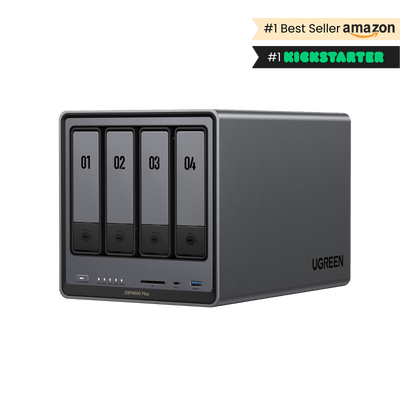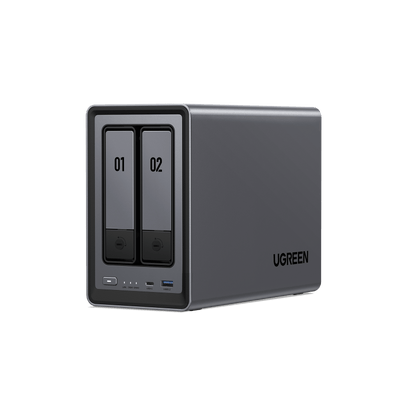How to Organize Your Family Data with NAS in 2025
From countless photos and videos to important documents and cherished family recipes, families today are creating more memories than ever before. However, managing this data can quickly become overwhelming. Imagine having thousands of photos scattered across phones, cameras, and laptops, with no easy way to find that one special moment from last year’s vacation.
While backups are an essential first step in protecting your data, true security comes from being able to always find, update, and share it. This is where the second data revolution begins, and it’s powered by NAS (Network Attached Storage). If you’re new to the concept of NAS, it might help to learn more about what it is and how it enhances data accessibility and security. You can explore this further in our article on what NAS is and how it works.

The Limitations of Backup Alone:
We’ve all been there: that moment of panic when you realize your precious memories, important documents, or family recipes are at risk of being lost. That’s where backups come in—creating copies of your files so they’re safe from accidental deletion or device failure. But here’s the catch: backups alone don’t solve the problem of finding what you need, when you need it.
-
Backup Doesn’t Solve the Clutter Problem:
Backing up your data is like collecting everything into one big box, but it doesn’t help you organize it. Sure, you’ve saved your photos, documents, and videos, but they’re likely scattered across multiple devices and backup locations. You might have backups on external drives, cloud storage, or even old hard drives you’ve forgotten about. But what happens when you need that one important document or the photo from your vacation? You end up wasting time searching through endless folders, trying to remember where you put it. To solve this, advanced features like those offered by AI-powered NAS solutions can help you automatically organize and retrieve your files more efficiently.
-
Backups Can Be Redundant and Overwhelming:
Without a system in place, you might end up with multiple copies of the same file in different backup locations. This redundancy creates more clutter and confusion instead of offering peace of mind. For example, you may find that you’ve backed up the same photo album several times—once on your laptop, again on your phone, and then on a cloud service—each copy taking up unnecessary space and making it harder to locate the most recent version.
-
Backup Doesn’t Help You Keep Track of Changes:
Another limitation of relying solely on backups is that they don’t account for how your data changes over time. Let’s say you’ve updated an important recipe or edited a family video. If you only have backups, you may not even realize that your most recent changes haven’t been saved or organized properly. Without a system that automatically updates and organizes your files, you’re left wondering if you’ve backed up the most current version.
-
No Quick Way to Access or Share Files:
A major frustration with basic backups is the lack of ease in accessing or sharing files. If you need to find a specific file or photo, you often have to browse through multiple devices and backup locations. Additionally, sharing files with others—whether it’s sending a document to your spouse or showing your child that long-lost family video—can become a hassle, especially if you’re not sure where the file is stored or if you’ve even backed it up at all.
NAS Revolution: More Than Just Backup
Now that we’ve seen the limitations of relying on backups alone, let’s talk about how NAS (Network-Attached Storage) takes data management to the next level. With NAS storage server , you’re not just protecting your data—you’re organizing, accessing, and sharing it in ways that make your life simpler and more efficient.

NAS allows you to store everything in one place that’s accessible from any device connected to your home network. No more hunting through multiple folders on different devices or cloud services. Everything is organized and easy to find—whether you’re on your phone, laptop, or tablet.
Automatic Organization and Tagging
One of the standout features of NAS is its ability to automatically organize and tag your files. For example, NAS can group photos by date, automatically assign labels based on file type (like “family,” “vacation,” or “work”), or even use facial recognition to tag people in your photos. This way, you never have to worry about forgetting where you stored that precious family photo or recipe again. With NAS, you can instantly locate what you’re looking for, no matter how many files you have.
{{UGPRODUCT}}
Easy Sharing with Family and Friends
With NAS, you can share photos, documents, or even entire folders with family members, whether they’re in the next room or across the country. You can set permissions to control who has access to specific files and folders, so you don’t have to worry about privacy or security. This is perfect for sharing family vacation photos, sending important documents to relatives, or collaborating on a project with others in the household.
Remote Access: Access Your Data Anywhere
Whether you’re on vacation, at work, or running errands, you can securely access your documents, photos, and videos from any internet-connected device. Imagine the convenience of pulling up your favorite family recipe while you’re at the grocery store, or showing friends your vacation slideshow from your phone.
Practical Benefits for Home Users
The Baby Photo Time Machine
Managing family data doesn’t have to be a chaotic game of hide-and-seek. Enter NAS, your digital hero, here to help you organize, back up, and access all your files with ease.
-
Never Lose a Memory Again:
Traditional backups only store static copies, but NAS version control acts like an attentive butler. Every time you save a file, NAS automatically creates historical snapshots—whether it’s the 30th draft of your kid’s kindergarten graduation speech or endless tweaks to a family photo album’s color grading. You can rewind to any moment in your creative timeline.
-
The Ultimate Family Collaboration Hub:
Imagine NAS as an invisible sticky note on your kitchen whiteboard:
- Household CFO Central: Shared folders auto-sort bills, tax documents, and grocery lists by month, with real-time co-editing for weekend project planning.
- Growing Up Archive: Create kid-specific accounts to organize school essays, piano recitals, and soccer goals by year—then generate a “Time Capsule” timeline for their 16th birthday.
- Senior-Friendly Access: Grandparents can browse family photos directly on the living room TV, while AI voice assistants help them search photos using casual phrases.
Conclusion
By moving beyond simple backups, NAS offers a smarter, more efficient way to handle your digital life. From organizing photos and school projects to keeping track of medical records and family finances, NAS revolutionizes the way you store, access, and share data—while giving you peace of mind knowing everything is securely backed up and easily accessible.




